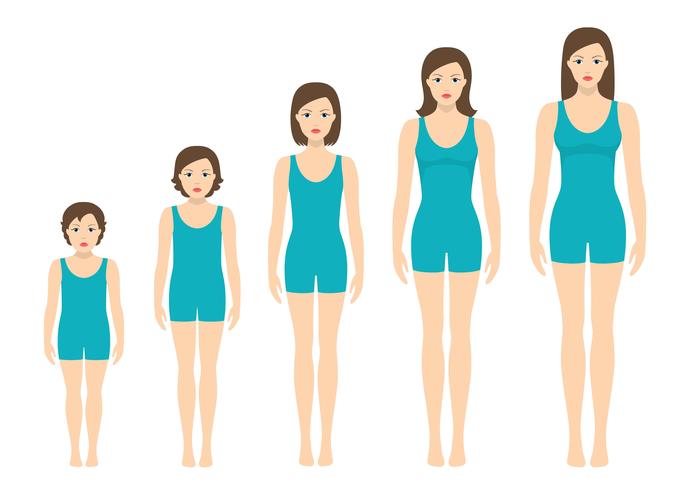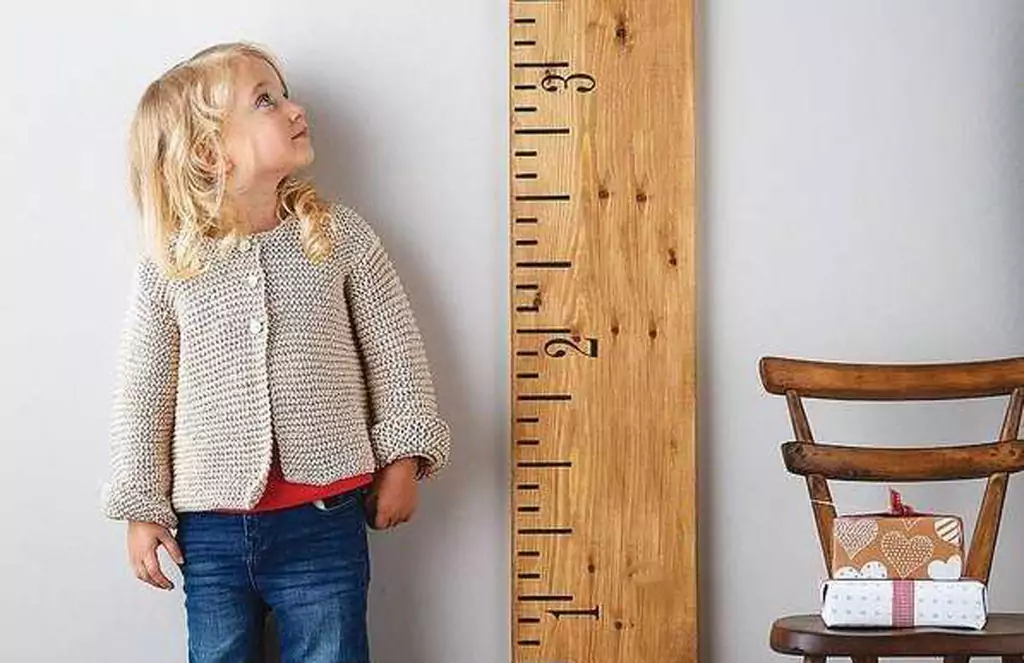When Do Girls Stop Growing? The Question Answered
Share

When do girls stop growing? This is a question that would have crossed every parent’s mind at least once. Puberty plays an important role in the pace of growth. Compared to boys, girls start and end puberty in a short time span. They tend to grow exponentially one or two years before their menstrual cycle starts.
By the time a girl hits puberty, she will have reached her full adult height. Still, there is a wavering confusion among parents of girl children about their growth patterns.
In this article, we will be going through some benchmarks you can keep in mind while monitoring the growth of your girl child and learning more about her general growth pattern.
When Do Girls Stop Growing?

As indicated earlier, in most cases, a girl stops growing two or two and a half years after reaching her first menstrual cycle. But again, you can’t always use the girl’s menstruation as an ideal metric to expect the girl’s growth to stop soon. Certain other factors might fit answers to the question, When do girls stop growing?’.
You can check the following indications to come to the conclusion that a girl has stopped growing.
- If no growth is seen in a girl’s height even after a year or more, you can reach the conclusion that she has stopped growing.
- When the body hair stops growing, it is an indication that a girl has attained maximum growth.
- A girl’s breasts, hips, and genitals will be fully developed when she reaches full growth.
- You can notice visible development in a girl’s physique and face that reflects an adult-like look.
Certain kinds of maternal tests can be conducted to check whether a girl has stopped growing. But this can’t be done if there are no concerns about the girl’s health. Following are the reasons that could lead to tests conducted by doctors to check a girl’s growth:
- Hormone Levels: With the help of a simple blood test, doctors will be able to analyze the growth hormone levels of a girl. With the help of this result and referring to the growth chart, it can be determined whether or not a girl has stopped growing.
- Pediatric Bone Age: This test is conducted by taking an X-Ray of a girl’s left hand and wrist. These images will be compared with a standardized growth index to determine pediatric bone age. You will be able to understand bone maturity level, nutrition level, and physical health.
There are certain ways that you can adapt to let your daughter grow in healthy ways. You can include nutritious food in her diet and ensure that she is getting an ample amount of sleep to promote healthy growth. Making your daughter follow a regular exercise pattern can also help her gain good physical growth.
Sharing the right and accurate family data with your daughter’s pediatrician can help him/her suggest appropriate measures to follow to promote the girl’s health in the right direction.
Growth Spurts in Girls

Usually, puberty-related growth spurts happen between the ages of 11 and 15, approximately. We can’t rely on an exact age interval while discussing the growth stages of a girl, as puberty hits each individual in a different way.
Although it is to be noted that girls won’t usually attain puberty before the age of 8, At the same time, medical attention must be sought if a girl doesn’t go through puberty even after the age of 15 or 16.
After observations by experts to determine the growth pattern of girls, it was noted that a girl’s growth will usually stop after two and a half years after her first menstrual cycle.
Below are listed the changes that are commonly seen during the growth spurt in girls.
- An exponential increase in height: Until the time of her first menstrual period, a girl will grow two to three inches per year. With careful observation, you will be able to see this sudden spurt in her height.
- Growth of Reproductive Organs: During the first growth spurt, the size of a girl’s vulva and labia will increase. Along with this, her internal organs, such as the uterus and vagina, will also start to grow.
- Development of Breasts: When it comes to breast growth in girls, you may not notice a sudden change in their size and appearance. A gradual change in breast buds, or areolas, will start during the first growth spurt, leading to bigger breasts and projected nipples.
- Sweating, acne, and Body odors: Oestrogen and progesterone levels will start to fluctuate in a girl’s body. This will result in changes in the skin’s texture, making it more oily and clogged. Due to this development, a girl will first experience acne, an increase in the rate of sweating, and body odor.
- Hair Growth in Pubic and Underarm Areas: During the first growth spurt, the presence of thin and fine hairs will be seen in the pubic and underarm regions of a girl’s body. As the girl ages and moves towards adulthood, the hair growth under the armpit and in the pubic area will be complete.
- Mood Swings: This is a common behavioral change seen in girls during their first growth spurt. During this time, the hormone levels of a girl will keep fluctuating at frequent intervals, resulting in fluctuating mood changes. Such unexpected and quick changes in mood are inevitable. Another reason that can further ignite such mood swings is the social pressure on a girl to get independent from her parents at this age.
- Change in Foot Size: This is one of the least discussed, but most visible changes noticed on a girl’s physique during the first growth spurt. A study conducted in 2009 and 2014 indicates that the feet are one of the first affected organs in a girl’s body during the growth spurt. You can easily recognize this change as your daughter’s foot starts to not fit in her footwear anymore. By the age of 12 or 13, she will likely reach the maximum foot size.
Once this initial puberty-related growth spurt reaches a standstill, the girl will start growing another one or two inches after her first menstrual period. But after this, it is highly unlikely for a girl to continue growing.
Average Height of Girls

A chart prepared by the Centres for Disease Control and Prevention (CDC) indicates the average median height of a girl in the US. As per the inferences drawn by the CDC, an adult woman will have an average height of approximately 63 inches.
Referring to this chart prepared by the CDC, it can be seen how the growth of girls almost comes to a standstill after the age of 15. Only a few more continue to grow until the age of 18.
It is also to be noted that this growth happens in a short span of time, as per this chart, from the age of 8 to 18. Even though the CDC has shared some numbers after extensive studies on growth patterns in girls, these aren’t conclusive results.
If a girl’s growth doesn’t happen as depicted in this chart, it doesn’t mean that something is wrong. There are a lot of factors that directly affect a girl’s body growth.
Girls and Growth Delays
Genetics plays a major role in determining the growth pattern of a child. Pediatricians often collect data regarding the height of the parents and their growth patterns to determine the growth of a child.
This is because the height of your parents can directly affect your growth. By using this data, you can somewhat predict a girl’s growth pattern. This approach is called the mid-parental method.
To try out the mid-parental method, you should first add the heights of the father and the mother together and then divide the result by two. Make sure to measure the values in inches.
Now, subtract 2 from the obtained value. If it is a boy, you can get an approximate prediction of height by adding 2 to 12 instead of subtracting it.
Growth delays can be seen in girls due to multiple factors. Some of them are caused by malnutrition, the intake of certain medications, hormone issues, arthritis, or even cancer.
There are exceptional conditions where a girl won’t grow after a particular height and stay short. Such conditions can be caused due to Down syndrome, Turner syndrome, or Nooner syndrome.
Also, a girl with Marfan’s syndrome can display symptoms of exceeding growth. This might make the girl grow taller than her parents.
Hence, it is always advised to consult a physician if a delay in growth is noticed in a girl. If a girl is facing a delay in growth, she might not have much time to grow in height before hitting the spurt.
Final Word
Seeing your daughter grow is a wonder. It is indeed important to know everything about your daughter’s growth pattern and analyze her health accordingly. With careful observation and familiarisation with a girl’s average growth pattern, you will be able to understand when your daughter might stop growing.
We hope our article was helpful in learning about various conditions that could affect a girl’s growth and when to look for an early puberty growth spurt.
Monitoring your daughter for any kind of growth issue is very important. If she attains puberty before the age of 8 or is facing late puberty, it is suggested to consult an expert’s opinion for a healthy improvement in her growth pattern.
Frequently Asked Questions
What Should Be Done if No Visible Growth is Seen in a Girl’s Physique?
There are two conditions to consider. Early puberty and late puberty When a girl doesn’t show visible physical changes by the age of 14 or hasn’t reached her first menstrual period by the age of 16, it is considered late puberty, and you should consult a pediatrician.
How Much Time Does a Girl Have to Grow?
Compared to boys, girls show a quicker growth rate. They continue to grow through their childhood until their early teenage years and resume growing after their first menstrual period. They will stop growing in height approximately by the age of 17.















